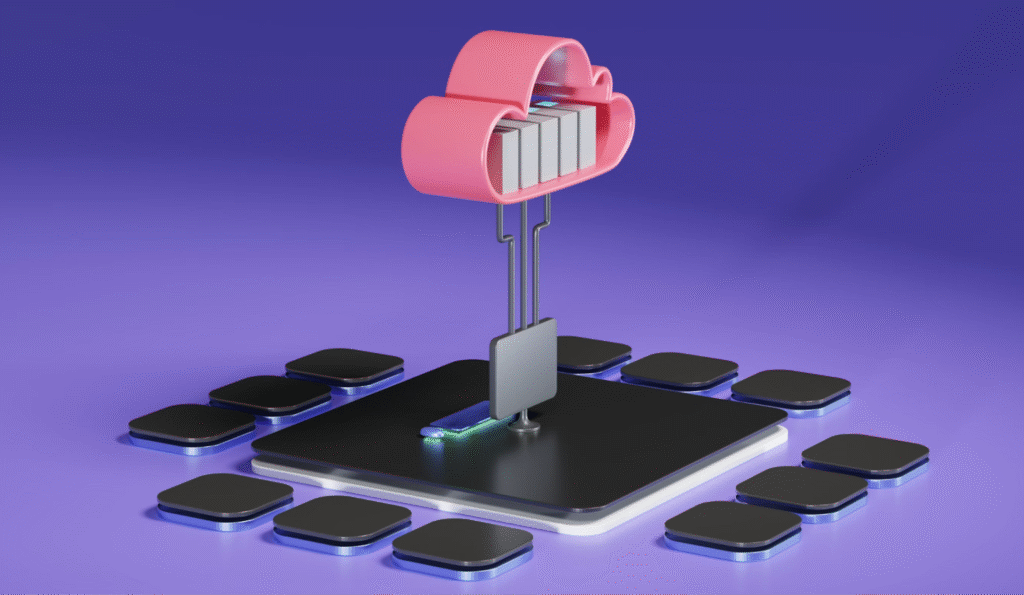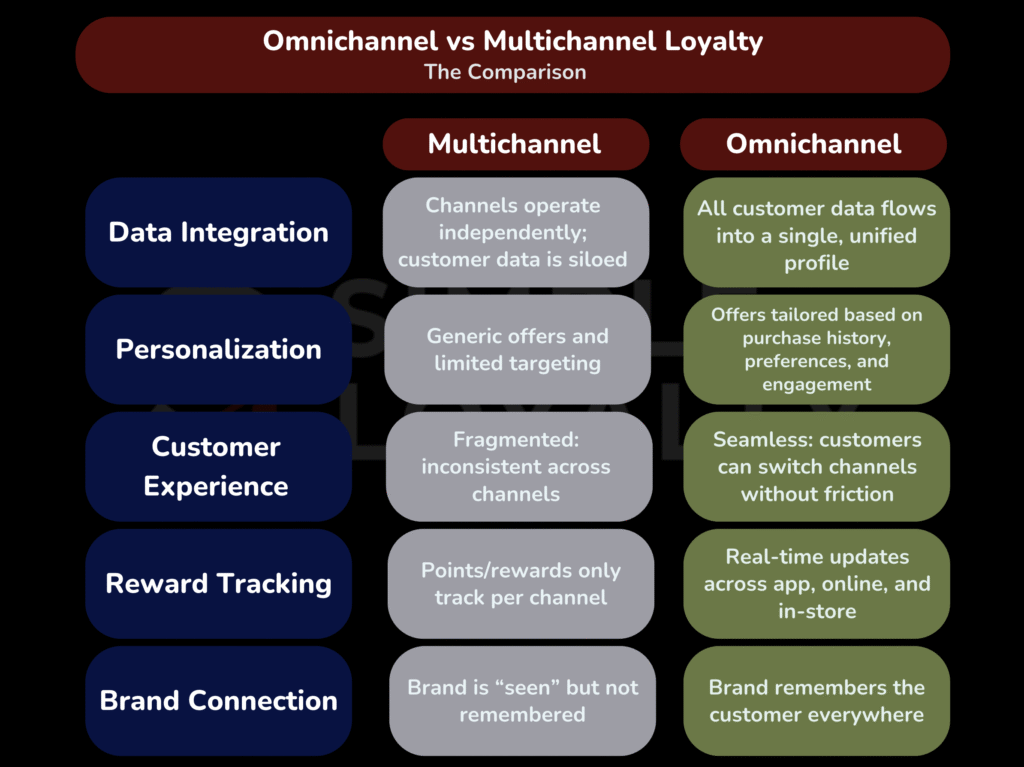Estimated Reading Time: 7 minutes

You know what’s frustrating?
You shop for something online, collect loyalty points—but when you walk into the store, your cashier acts like that never happened.
That disjointed “wait, which loyalty account?” moment is exactly what kills brand love. And that’s the clearest difference between omnichannel and multichannel loyalty.
This is the core omnichannel vs multichannel debate.
Multichannel loyalty touches customers in multiple places, but rarely in sync. Omnichannel loyalty programs, on the other hand, is the glow-up. Seamless, data-driven, and personalized everywhere your customer interacts with you.
Whether you’re comparing omnichannel vs multichannel retail setups or omnichannel vs multichannel marketing strategies, the question remains the same: which truly strengthens customer retention?
In this article, we’ll settle the score once and for all. You’ll learn the difference between omnichannel vs multichannel loyalty (because yes, there is a stark difference), see how it impacts customer experience, and discover why in 2025, a true omnichannel loyalty strategy is becoming the standard for brands that want customers to stay loyal, not just subscribed.
Defining the Two: Don’t Mix Them Up
What Multichannel Looks Like
Multichannel loyalty is like having several instruments playing… but no conductor. You’ve got an app, an email newsletter, social media pages, maybe even a physical store (all running separately).
Each channel does its own thing: customers might earn points on your app, get promos by email, or show a punch card at the counter. But none of it talks to each other. A customer’s digital profile lives in one silo, their in-store purchase history in another.
In other words, multichannel is about presence, not cohesion. The customer sees your brand everywhere but doesn’t experience continuity.
Sure, you’re technically “reaching” your audience. But you’re not connecting. It’s efficient for marketing output, not for customer experience.
Think of multichannel as brand visibility without brand memory.
What Omnichannel Actually Means
Now, picture this: your customer walks into your store, and the cashier already knows they’ve earned points from last night’s online purchase. The app updates their tier status instantly, and a personalized offer pings their phone before they even reach the checkout.
That’s omnichannel.
Omnichannel loyalty breaks down in silos and merges data across every channel—in-store, online, mobile, social—into one cohesive system. It’s powered by integrated tech (CRM + POS + loyalty platform), so customers experience one unified journey.
In simpler terms: multichannel is presence; omnichannel is connection.
And connection is what actually builds retention.
The Customer Experience Divide
Data Integration and Personalization Power
Wanna know the secret sauce? Omnichannel loyalty thrives on connected data. When all your customer touchpoints feed into one centralized view, personalization becomes second nature.
You can greet customers by name, anticipate their needs, and recommend relevant rewards instead of throwing random discounts at them. (Trust us, no one needs another “10% off” email with zero context, thanks).
For example, if a fitness brand sees that a customer consistently buys yoga gear online, an omnichannel system might send them in-store offers for yoga classes or mats. Meanwhile, a multichannel brand might just blast them with a generic “sportswear sale!” email. Boring. Snoozefest.
This kind of personalization is exactly what modern consumers expect. A study shows that 89% of customers are more likely to stay loyal to brands that understand and remember them. Omnichannel is how you can make that happen.
Frictionless vs Fragmented Journeys
Customer experience can make or break your loyalty program.
A multichannel journey often feels choppy. Like switching tabs on your browser. Your customer gets a promo email, clicks it, but then finds the offer isn’t valid in-store. They lose interest, maybe even trust.
An omnichannel journey, however, feels smooth and continuous. Customers can start a purchase on one channel and finish it on another, with points and rewards updating instantly in real time.
Where multichannel creates friction, omnichannel creates flow.
That frictionless experience doesn’t just make things easier, it cements trust. When customers see that your brand remembers them everywhere they go, they feel valued, understood, and far more likely to engage again.

Case Studies: Omnichannel in Action
Seeing omnichannel loyalty in theory is one thing… but watching it work in real life is another. These two brands prove how integrated systems can completely transform the customer journey.
Decathlon
Decathlon launched a loyalty program in 62 stores in just three months and managed to identify 44% of offline purchases via their loyalty system.
In Malaysia, Decathlon has deepened its digital footprint via a tie-up with Lazada. The goal is to make sporting goods more accessible nationally, build brand awareness, and more tightly integrate online + in-store experience.

Key features (omnichannel elements):
- Offline purchases being tied to loyalty (i.e. customers’ loyalty status/data connected with in-store transactions) so data isn’t siloed.
- Strengthened digital channel via LazMall (Lazada) partnership, plus email, social media, offers online + in-store.
- CRM/database building and lifecycle marketing are part of their strategy in Malaysia. (e.g. working with Elixus for email + social media buying to drive awareness + engagement).
What it shows:
- Identifying offline purchases via loyalty lets you personalize better, close data gaps (so offer redemption, frequency, purchase history all sync).
- Having both offline + online channels well connected means the customer feels the brand in one unified way (less confusion, more trust).
- Partnerships (online marketplaces) help reach customers who prefer digital, and can be drawn into in-store experiences.
Watsons Malaysia
Watsons Malaysia runs the Watsons Club loyalty program, boasting over 8 million members nationwide.
They’ve increasingly leveraged online + offline channels. For example, the “App-rything For You, App-ryday” campaign where deals exclusive to the Watsons Malaysia App, use of the app for digital stamps (e-Stamps) from purchases both in-store and online, plus in-app exclusive offers.

Watsons has also built a large merchant touchpoint network: W Rewards across >5,000 partner locations in Malaysia, where members can redeem points/vouchers (not just at Watsons stores).
Key features (omnichannel elements):
- App-exclusive deals combined with in-store purchase benefits.
- e-Stamp programs to track purchase frequency across channels.
- Expansive partner network beyond their own stores (F&B and lifestyle) so that redemption & rewards happen in more places.
- NFC Touch ‘n Go functionality in member cards and digital coupons. Some features like “Share Points” allow members to share or gift points to others.
What it shows:
- Identifying offline transactions and syncing them with online behavior bridges the data gap between channels. This ensures members get consistent rewards no matter where they shop. The broader partner ecosystem keeps engagement alive outside Watsons’ own stores— showing how omnichannel loyalty can extend brand relevance into everyday life.
Both Decathlon and Watsons prove that omnichannel isn’t just a buzzword. It’s what happens when you unify your tech, data, and customer experience under one roof. This means higher engagement, deeper loyalty, and a brand customers genuinely trust.
Why Omnichannel Loyalty Wins in 2025
Unified Data = Unified Experience
In 2025, customers won’t think in “channels”. They’ll just see your brand. And if your brand experience feels inconsistent, they’ll notice… and leave.
Omnichannel loyalty lets you deliver a connected, real-time experience by merging all customer data under one roof. When your POS, eCommerce, and CRM (Customer Relationship Management) systems sync with your loyalty platform (say, through a platform like SimpleLoyalty), you can:
- Track behavior across channels
- Automate personalized rewards
- Predict when to re-engage customers before they churn
Instead of reacting to behavior, you anticipate it. Instead of guessing what customers want, you know.
It’s not just future-proofing your loyalty strategy, it’s how leading brands build genuine customer relationships today. You can absolutely do the same with your brand. Don’t say we kept it from you.
Conclusion
Loyalty isn’t about being everywhere, it’s about being everywhere, together. Multichannel talks at customers. Omnichannel talks with them.
While multichannel loyalty focuses on visibility, omnichannel loyalty focuses on connection. It’s what transforms casual buyers into loyal fans, and one-time purchases into long-term relationships.
So if you’re still juggling disconnected loyalty systems, now’s the perfect time to evolve. Start integrating your data, unify your customer journey, and build a loyalty program that feels like magic. For you, and your customers.
Ready to make the switch?
Platforms like SimpleLoyalty make it easy to unify your systems, automate personalization, and create the seamless loyalty experience your customers already expect.

